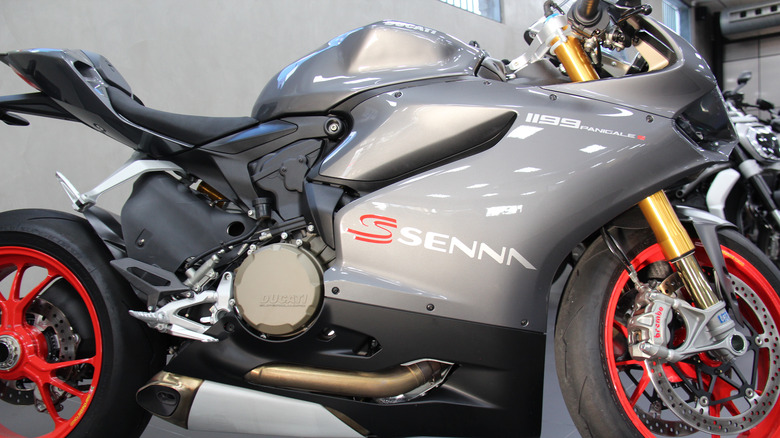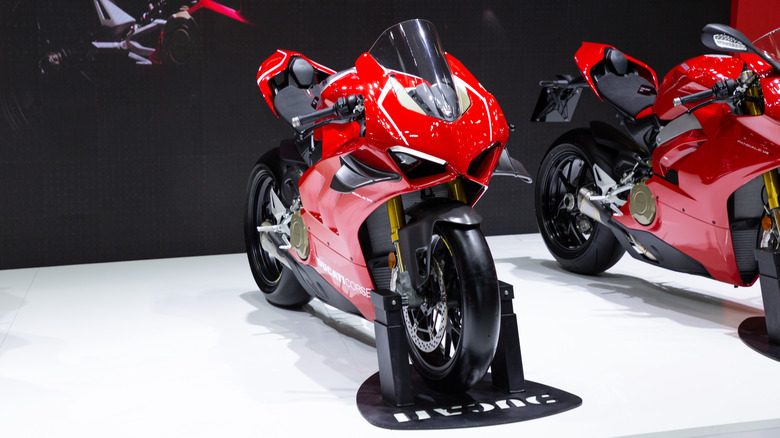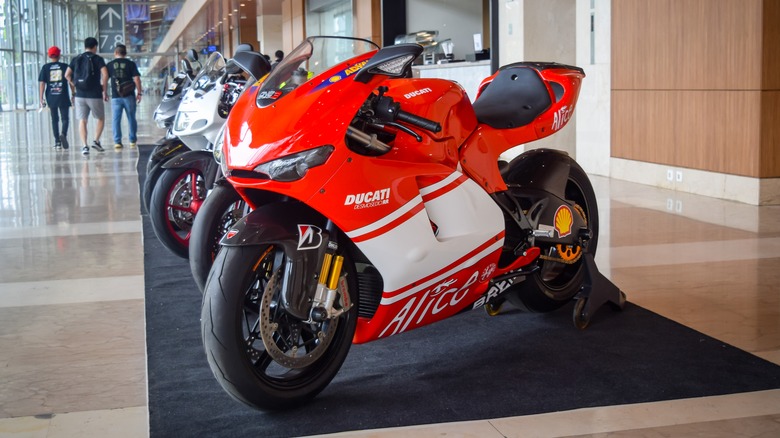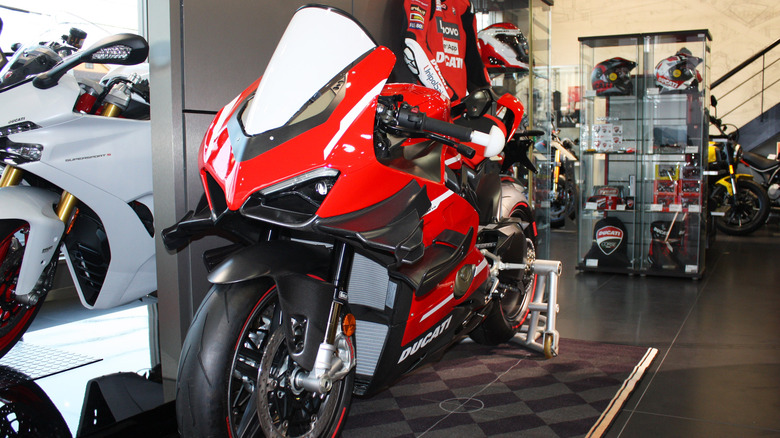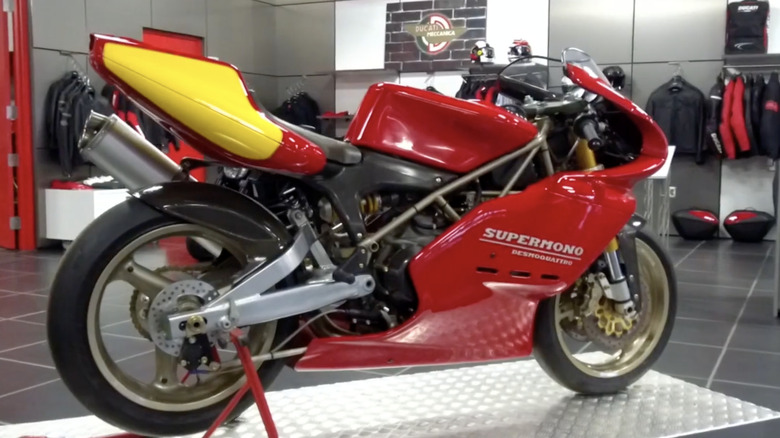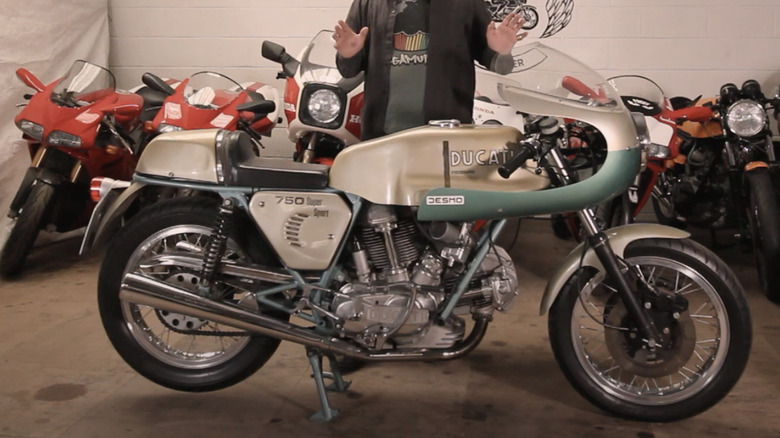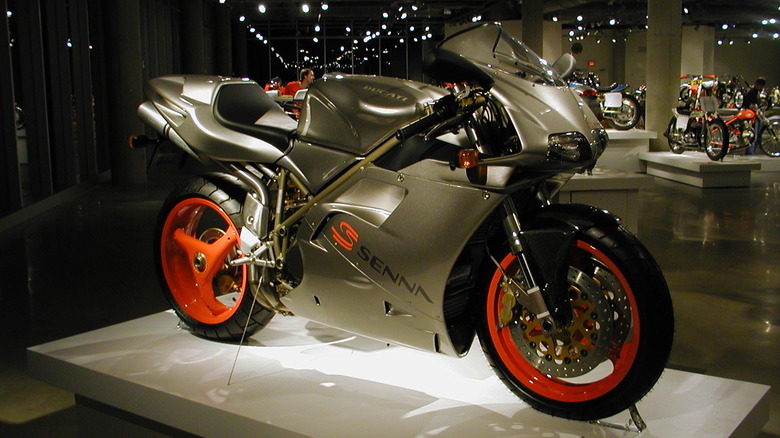6 Of The Rarest Ducati Motorcycles Ever Built
Italian companies are known for making some of the world's most coveted products across many industries, from fashion brands like Gucci and Prada to renowned carmakers Ferrari, Lamborghini, and Alfa Romeo. Italian products are held in high regard for the level of craftsmanship and exquisite design elements that are a part of the nation's manufacturing tradition. In 1926, Adriano, Bruno, and Marcello Ducati founded the motorcycle manufacturer that bears their surname in Borgo Panigale, just outside Bologna. Since then, Ducati has become a global leader in the production of exotic sport, touring, and adventure motorcycles.
Much of that reputation has been built on Ducati's success on the racetrack — Ducati riders have won multiple championships and took home the 2023 MotoGP, World Superbike, and World SuperSport crowns. Ducati has built many bikes that carry that proud racing tradition onto public roads, and its motorcycles tend to be on the expensive side, including one model that carries a price tag of more than $100,000.
Most of Ducati's hand-built bikes are relatively rare when compared to the mass-produced models made by the likes of Yamaha, Honda, and Harley-Davidson, but some have had limited production runs of just a few hundred units, and a couple of Ducatis haven't even approached the 100 unit mark. Here are six of Ducati's rarest motorcycle models and a quick rundown of exactly what makes each one so special.
Panigale V4R
The Panigale line debuted in 2011, and Ducati updated it several times in the following years with the newest technology and a handful of limited-release racing and special edition versions. In 2018, Ducati introduced the V4R, its first motorcycle with a four-cylinder engine. That 1,103 cc powerplant produced 214 horsepower and 91.5 pound-feet of torque, which made it Ducati's most powerful motor ever.
The racing-spec V4R has a Desmosedici Stradale R 998 cc engine that surpasses its larger cousin in output with its 218 horsepower maximum capacity, due in part to its astonishing 16,500 rpm redline. When outfitted with Ducati's racetrack-only exhaust system, the Stradale R engine's output jumps to a spine-jiggling 237 horsepower.
The V4R incorporates several bits of innovative technology Ducati developed for its racing series bikes, and the manufacturer's website refers to the V4R as "the closest production model to a competition bike ever." The V4R is limited to a run of 500 units and carries a sticker price of nearly $45,000.
Desmosedici RR
The Desmosedici is Ducati's MotoGP race model, and for several years after its debut on the track in 2003, you had to be a professional to find yourself seated atop one. In 2006, Ducati realized it had plenty of eager customers willing to pay top dollar for a Desmo they could ride on public roads, and the Desmosedici RR was born. It went into production in 2006 with a run of just 1,500 units and a price of $72,500. While many so-called "race replica" bikes are neutered versions of their on-track counterparts, the Desmo RR was a faithful stem-to-stern recreation of the GP6 machine that Troy Bayliss rode to victory in Valencia, Spain, in the final race of the 2006 MotoGP season.
The Desmosedici's 990 cc V4 engine produces 250 horsepower and can hurl bike and rider to a top speed of 215 mph. Bryan Catterson of Motorcyclist called the Desmo RR "literally the most high-tech, powerful and purposeful sportbike ever offered to the public." But after a test ride, he concluded it would likely be too stiff and hard to handle for everyday use.
"Riding Ducati's Desmosedici RR is a bit like commuting in a racecar," he wrote. "Granted, its heart-stopping exhaust note paralyzes your brain with pleasure tremens, and no other production machine can tractor-beam liter-bikes as effectively on a long straight. The Desmo is indeed as close as you can get to a MotoGP bike for the street. The question is: Does a MotoGP bike belong on the street?"
Superleggera V4
The Superleggera (Italian for "super light") V4 represents Ducati's cutting-edge efforts concerning lightweight materials, a powerful engine, and the latest electronic rider assist and safety systems. Much of the Superleggera is made of carbon fiber, including the frame and rear swingarm, and titanium and magnesium are used liberally throughout the rest of the bike to keep the weight to 350 pounds (335.5 with the optional racing kit). The 998 cc Stradale V4 motor in the Superleggera V4 puts out 234 horsepower and 87.7 pound-feet of torque, but Cycle World's Michael Gilbert found that the bike's impeccable balance and sophisticated traction control and braking systems kept that power from becoming unmanageable.
"Turn-in effort and precision are like nothing I have experienced on a Ducati; the chassis and fork provide a level of feedback that is incomparable to any production bike I have tested," he wrote. "Power delivery and the Superleggera's relentless corner-exit drives are remarkably impressive, but even more remarkable is the user-friendliness."
That sophistication and refined power come at a high cost, however: the Superleggera V4 has a base price of more than $100,000. For that expenditure you could have two Panigale V4Rs or a garage full of Janus Halcyons and Kawasaki W800s, although riding a Superleggera would put you in the company of Hollywood A-listers like Tom Cruise and Jason Statham, who rode his V4 onto the set of "The Expendables 4." Like the Panigale V4, the Superleggera V4 was limited to a production run of 500 units.
Supermono
Compared to the Supermono, the Superleggera and Panigale V4s are veritable mass-market bikes. The Supermono was made to compete in the single-cylinder FIM Supermono championship, and only 67 were built between 1993 and 1995. Young engineer Claudio Domenicali was entrusted with the design of the Supermono, and he clearly impressed the powers that be in Borgo Panigale, for he is now Ducati's CEO. The Supermono's engine had a displacement of 550 cc and a power output of 75 horsepower, which might sound modest in comparison to some of Ducati's beastlier V4s, but that motor was enough to haul the 220-pound bike to a top speed of nearly 137 mph.
That efficient performance was partly credited to the lightweight ALS500 tubular steel frame and carbon fiber fairing, seat, and body panels. The wheels and crankcase cover were made of magnesium to save even more weight, and the Supermono was an immediate success on the track, winning its namesake championship in 1993 for rider Mauro Lucchiari. The very limited production run has made the Supermono one of Ducati's most coveted collector's items today, with auction prices often approaching $200,000.
1974 750 Super Sport Desmo
Flipping back the calendar a few decades brings us to the release of the 750 Super Sport Desmo, which featured the desmodromic valve system that would eventually provide the basis for half of the Desmosedici's portmanteau moniker. The 750 Super Sport made its debut at the 1973 Milan Motor Show and hit racetracks and showrooms the following year. It was limited to 401 production units and had a striking design, with a green tubular frame and curved fairing with open sides.
The 750 Super Sport was only made in 1974, and its 748 cc L-twin engine put out 70 horsepower and could propel the bike to a top speed of 130 mph. That figure rivaled that of the 900 cc four-cylinder Kawasaki Z1, which at the time was considered the world's fastest production motorcycle. Ducati has used the 750 and Super Sport designations on many other bikes since then, but most of them have had much larger production runs than those of the original 750 Super Sport.
916 Senna
When Ducati debuted the 916 at the 1993 Milan Motor Show, Brazilian Ayrton Senna had already won three Formula 1 driver's championships for McLaren and was the proud owner of a Ducati 851, the first new model built in Borgo Panigale under Ducati's new owners Claudio and Gianfranco Castiglioni. Senna and Claudio became close friends and decided to partner up on a special Senna edition of the 916 in early 1994.
Senna officially signed his deal with Ducati in March, but he died in a tragic crash at the San Marino Grand Prix that May just a few miles from the Ducati headquarters. Reservations for the limited run of 300 Senna edition 916s had sold out weeks before, but production was pushed back from early summer until December when Ducati presented the bike at a special ceremony at the Bologna Motor Show. In attendance were Claudio Castiglioni, F1 drivers Jean Alesi and Pier Luigi Martini, and Ayrton's brother Viviane. Viviane is the co-founder and current president of the Instituto Ayrton Senna, a charitable foundation that works to give economically disadvantaged Brazilian youngsters access to educational opportunities.
It had been Ayrton's wish that proceeds from the sale of the bike that bore his name would go to support the foundation. Ducati released Series II and II versions of the 916 Senna in 1997 and 1998 in colors chosen by his and Viviane's younger brother, Leonardo. Those bikes were also limited to production runs of 300 units each.
[Featured image by Mike Schinkel via Wikimedia Commons | Cropped and scaled | CC BY 2.0]
